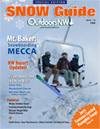How Avalanche Dogs Train

The fluffy superheroes of the Northwest
By Megan Hill
Photo at right: Avalanche rescue dog Hoss has been certified for emergency work on the Backcountry Avalanche Rescue K9s (BARK) team at The Summit at Snoqualmie for several years. (Certification takes about three years to obtain.) Photo by Guy Lawrence, courtesy of The Summit at Snoqualmie
Their names are Hoss, Scout, Maple, Josie and Stanley, and they’re fluffy and adorable. They’re also trained to save your life.
Avalanche rescue dogs are trained at ski areas across the Northwest to work with their human counterparts to respond to an avalanche—both inbounds and in the backcountry. Typically working breeds like Labradors, Border Collies, Shepherds and Golden Retrievers, the dogs have been trained to sniff out skiers buried in the debris, alert human rescuers and start digging.
These specially-trained canines are essential in situations where skiers are buried without avalanche transceivers in the backcountry or in cases where rescuers have no other signs to go by, like an airbag that’s floated to the surface or visible pieces of gear and clothing.
Dogs have been used in avalanche rescue since the 1970s, says Chris Hunter, the ski patrol supervisor in charge of accident investigation who also serves as the avalanche dog team leader at the Stevens Pass Ski Area.
He explains the dogs are trained extensively from puppyhood before they’re placed on rescue teams. Each puppy works with a trainer, and the two often develop a close relationship over the course of about a decade.
Training involves focused play that keeps the dogs interested and engaged and having fun. Trainers slowly break the dogs in, getting them accustomed to deeper and deeper holes in the snow, playing hide-and-seek, and rewarding them with treats. For the dog, the real rescue is simply another game.
“Avalanches are relatively rare occurrences,” says Hunter.
“I’ve seen four live missions in the 11 years my dog has been alive,” he says, estimating he responds to only a handful of avalanches each season. There are times when an avalanche occurs and it’s unclear whether any skiers were involved. In fact, the first task is often to simply determine whether any skiers were in the path of the slide.
But, avalanche rescue teams are always poised in case the call does come. In the event of a slide, rescuers must think and act fast: buried skiers are clinging to a 40-percent survival rate after 15 minutes of burial. That number plummets to 25 percent after 30 minutes.
Dogs are called to the scene of an avalanche only after a first-response unit called the “hasty team” has assessed the terrain. Then, a determination is made regarding whether the avalanche dogs are needed. If so, the dogs wander the field, their noses pointed to the ground. They’re trained to alert their human teammates when they’ve located a skier.
“The dog starts digging and barking,” says Kevin Huggett, training coordinator for the Backcountry Avalanche Rescue K9s (BARK) at The Summit at Snoqualmie’s Alpental ski area.
“Mainly they’re digging. They’ll get in, get the scent of the person, and start digging down and they’ll use their nose to isolate in.” Hunter’s best advice for staying safe in avalanche territory is to ski with a partner. In the backcountry, skiing down a slope one at a time means one person is always out of harm’s way.
Megan Hill is a food, travel and outdoors freelance writer based in Seattle. A native of the Deep South, Megan moved to the Northwest to be closer to the mountains.
Resource:
The Northwest Avalanche Center (NWAC) is a great source of backcountry information: www.nwac.us



